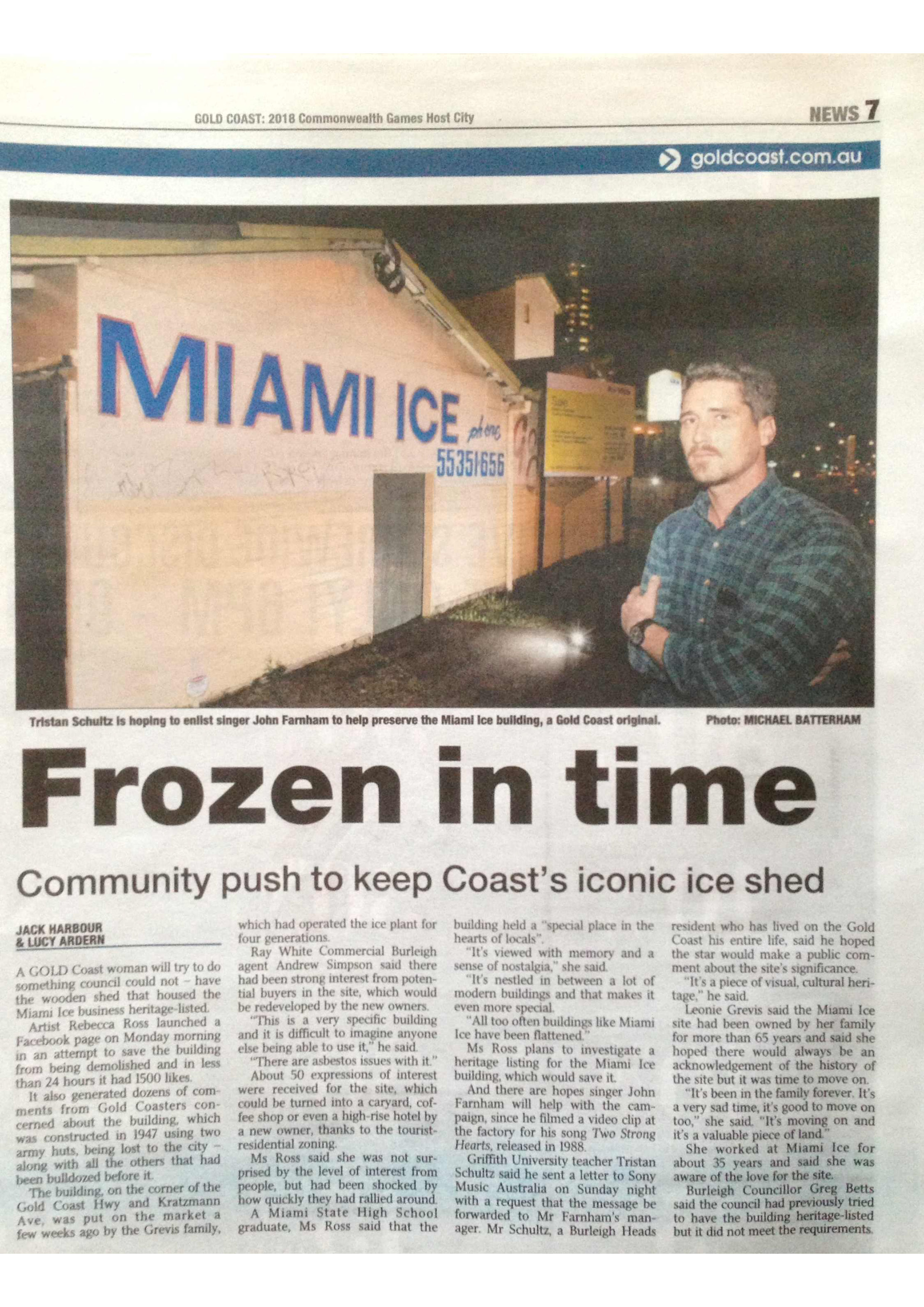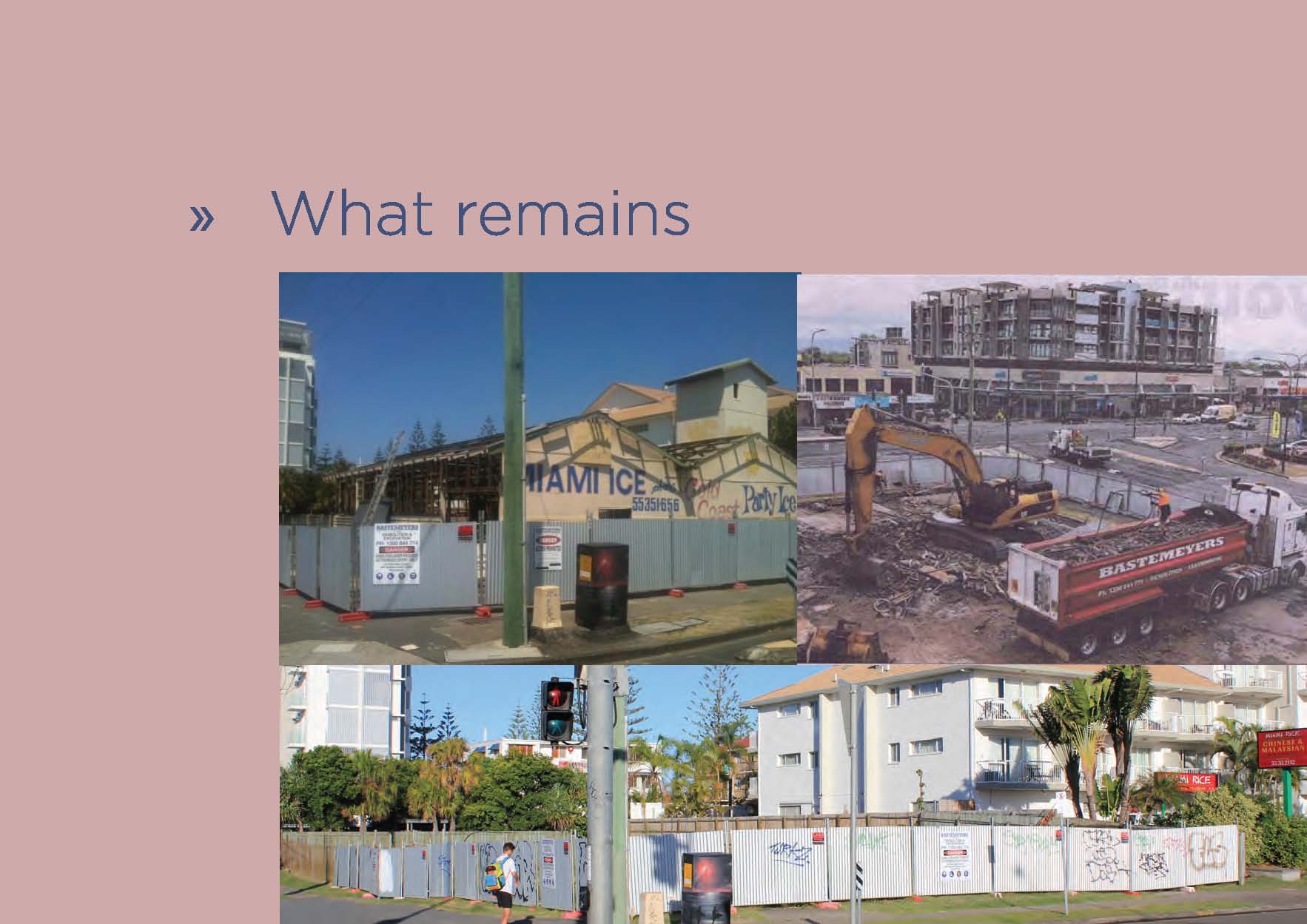The Save Miami Ice campaign, a test of Gold Coast's heritage policies.
The Save Miami Ice campaign, undertaken by founder Tristan Schultz and local artist Rebecca Ross, was an experiment in defining a particular situated problem and placing the discussions of its future within a much larger domain of relational complexity. The object that mediates the larger conversation is an iconic structure in a prominent position up for sale on the Gold Coast Highway. The obvious narrative is saving the structure for its historical and cultural significance. The meta-narrative is bringing into existence a critical conversation about the nature of Gold Coast culture, characteristically a culture of rapid development and transience. Preserving the site is about setting precedence for acknowledging the past in the present for the future. It’s about confronting the unsustainable forces of perpetual growth and respecting memories retained in ‘place’ in order for community to articulate a sense of belonging.
The Save Miami Ice campaign began early 2013. Its success was not as much in saving the building (because, well, we didn’t) as it was in elevating and contributing to a conversation spawned by its actions, now taking place on the Gold Coast, such as in forums as the Fibro Coast, around preserving the past in the present for the sake of the future.


These are the four options for the space we saw potentially unfolding, in order of our desires. Unfortunately, not even the last option reflects what remains; a 10-storey high rise with no connection to Miami Ice and its history all but almost gone.
- The owner sells the site to council or state govt. The council or state govt list it as a heritage listing as a site of cultural significance, historically for its relation to the war, politically for its relation to modern small business commerce that now is nonviable, architecturally as a unique place making benchmark for the suburb, culturally for its signage and associated connotations with the golden years of GC along with its connection to other coastal towns such as Miami Florida, along with celebrating analogue typographic signage from the last half of the 20th cent. that Gold Coast was once famous for. All these things combined provide a compelling collection of narratives that the site can exhibit. A space as a public community centre, stopover point, coffee and ice cream shop, tourist information center, and potentially an iconic light rail station! The significance of a site such as this for the 2018 Commonwealth Games is extremely valuable. Imagine the branding and marketing of a tourist light rail stopover at ‘Miami Ice’! The commonwealth Games package desperately need place making icons such as this to present to the world as a depth and flavour of the Gold Coast that celebrates both growth and development in modern architecture but also retains the past in the present for the future to remember, admire and participate in. The Gold Coast is one of the fastest growing corridors in Australia, the state govt must recognise and protect sites of cultural heritage for the long term, so that new arrivals in our great city have a diverse range of iconic ‘places’ big and small that they can immerse themselves in, that represent colourful histories of their new city. All this combined legitimises the responsibility on the state govt to pay more than market value for the site due to its potentiality and public interest.
- The community and philanthropists buy the site, paying more than market value to the seller. Their intentions are as above outlined however it is independently run, with the aim of developing a compelling ‘informal’ destination for the 2018 Commonwealth Games and beyond.
- A developer purchases the site. Due to the sites cultural significance the developer pays more than market value and is able to capitalise in the media and public interest in their marketing campaigns. They capitalise on the value and integrate a reconstructed facade of the front silhouette of Miami Ice and tower into the building design, providing 2 x retail space (shed 1 and shed 2). The narratives of Miami Ice are retained in a display for public viewing. The branding strategy capitalise in the pop culture connotations of vintage and market to young singles and couples wishing to live at ‘Miami Ice’, close to beach and amenities. Such a development has the potential to re-code the negative stigma of the particular area in close proximity to the site, which is due for re-coding before the Commonwealth Games.
- A developer purchases the site. Due to the sites cultural significance the developer pays more than market value and is able to capitalise in the media and public interest in their marketing campaigns. They do little more than offer a tokenistic memorial to the foyer of their development.